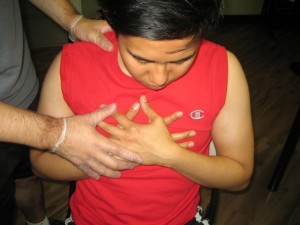A fractured sternum or sternal fracture happens when there is a crack or break in the breastbone or sternum. The sternum is a vertical bone found in the center of the chest together with 12 ribs which forms the anterior part of the chest. The sternum together with the ribs to which it is connected forms an enclosure for the tissues and vital organs such as the lungs and the heart. A direct strike to this area can result to a fractured sternum.
Causes of a fractured sternum
- A direct and disturbing blow due to an object to the chest especially with vehicular accidents where the chest forcefully hits the steering wheel.
- Struck by a ball in the chest while playing hockey or rugby.
Symptoms

- Sudden onset of pain in the chest when the injury happens. A spasm type of sensation can be felt in the center of the chest.
- Pain in the chest becomes worse at night or after waking up in the morning.
- Pain becomes worse when lying down in certain positions such as lying on the side or facing down.
- Pain can be felt when applying pressure on the affected area.
- Pain when bending forwards, sideways, arching backwards and twisting.
- Movements of the upper limbs such as pushing, pulling, lifting heavy objects and overhead movements can also cause pain in the chest
- Swelling and bruising of the affected area
- Difficulty breathing
- Visible deformity of the chest
- Pain when coughing, inhaling deeply, laughing and sneezing
Treatment
- Take plenty of rest especially the affected chest. Avoid performing activities that can worsen the pain such as lying face down and application of pressure on the affected area. The average time for the fractured sternum to fully heal is about 2-3 months.
- Apply a cold compress on the affected area on the first 72 hours after the injury to lessen the pain and swelling caused by a fractured sternum. Apply an ice pack on the area at least 15-20 minutes for every couple of hours. Avoid applying an ice pack directly on the skin to prevent frostbite or making the condition worse. Wrap the ice pack with a towel before applying on the affected chest.
- Take an over-the-counter pain medication such as naproxen and ibuprofen to lessen the pain, swelling and inflammation.
- Immobilization of the joint for fast healing of the fracture and for proper alignment of the affected area.
- Perform deep breathing exercises as long as it does not cause pain to prevent collapse of the lungs. This should be done when the fractured sternum is totally healed.
- Once the fractured sternum is already healed, gradually return to regular activities as long as it does not cause worsening of the symptoms.
- Seek the help of a physical therapist for some rehabilitation exercises for improvement of the flexibility, strength and posture to prevent stiffness and weakness of the area.
- Wear chest guards or padding while playing sports to avoid future injuries
How Do I Learn More?
The information posted on this page on skeletal injuries, including fractured sternums, is for educational purposes only. To learn to recognize and manage bruised, broken, dislocated and fractured bones register for a first aid and CPR course in your area. Our training centres are located throughout Canada including in Edmonton, Calgary, Vancouver, Toronto, Winnipeg, Ottawa and Halifax.
